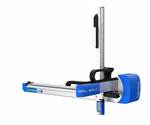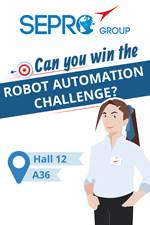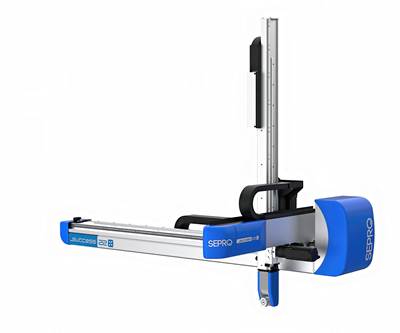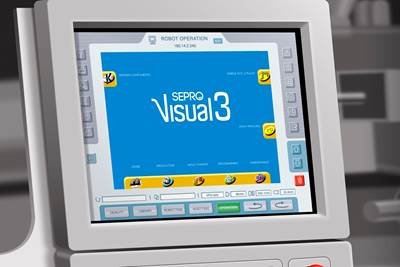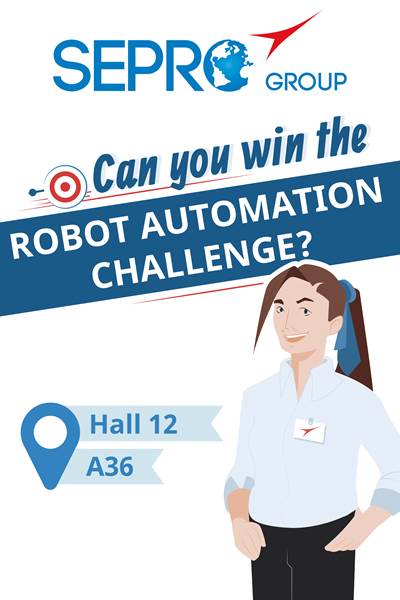Fakuma 2023: Sepro Introduces Its Fastest Top-Entry Robot, Integrative Controller
The concept ThundeRbot enters and exits the mold with parts in 0.79 second, while the Sepro Visual+ controls all the peripheral equipment in the show cell.
Sepro Group brought a total of 13 robots to the Fakuma 2023 trade fair, stressing that robots must be paired with other automated equipment — insert-feeding, assembly, marking, inspection and packaging systems — to provide a more complete automation solution.
To demonstrate this approach, Sepro operated a cell that featured a Sepro 5X-15 Cartesian robot with servo-driven wrist, and a 6X-140.2 articulated-arm robot serving an operating 110-ton Milacron injection molding machine. The robots and peripheral equipment were all controlled by the Sepro Visual+ controller.
In addition, operational data from the two robots and the molding machine were collected and analyzed by the new Sepro Connect dashboard. To demonstrate the full possibilities of Sepro Connect, the system pulled data from various cells in multiple locations. At Fakuma the display showed data not only from the Sepro booth but also from a remote customer site, the Sepro technical center in France and from Sepro robots running on the Fakuma stands of machine manufacturers Sumitomo Demag, Milacron, Billion and Borche.
The dashboard provides real-time insights enabling users to log in from anywhere and see an overview of all the connected cells, including working status, production progress, scheduled maintenance and energy consumption. All data is stored in a secure cloud location. The system can also send alerts if energy consumption deviates from set points.
Top Speed
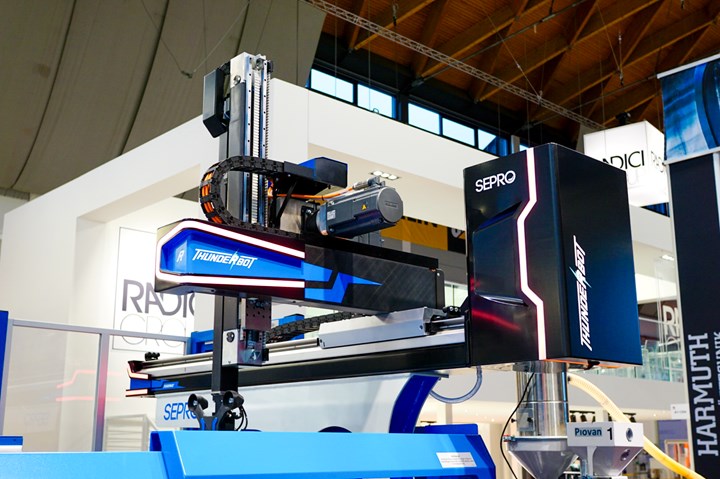
Sepro’s concept ThundeRbot used a series of design and material changes to achieve acceleration rates 45% faster than its fastest robot. Photo Credit: Sepro
Sepro also used Fakuma to debut the fastest top-entry robot it has ever built. Sepro says the ThundeRbot concept machine demonstrates the shortest possible cycle time. Using a specially modified Success 11 robot, Sepro was able to achieve Z-axis acceleration rates that are 2.6 times faster than the base unit. At the show, the ThundeRbot ran on a Sumitomo Demag machine molding small cups. The overall cycle time was just 3.07 seconds and mold-open time — during which the robot arm enters the mold, removes the part and exits again — clocked in at just 0.79 sec.
The ThundeRbot’s Z arm can accelerate at 80 m/s-2 (meter per second per second). For comparison’s sake, Sepro’s heretofore fastest robot, the S5-25 Speed, accelerates at 55 m/s-2 and the standard Success robot clocks in at 30 m/s-2, which makes Thunderbot’s acceleration 45% faster than the Speed and 2.6 times faster than the Success.
A lighter Z arm can accelerate faster than a heavier one, so the Sepro team focused on cutting its weight, eventually reducing it by roughly 6 kg (13.2 lb). About half of the savings came by making moving Z-axis beams from a pultruded carbon-fiber-reinforced composite instead of aluminum and applying hollow linear guide rails.
A 3D-printed end-of-arm tool (EOAT) was used, with air conduits to actuate the gripper molded into the body of the tool, eliminating external tubing and fittings. The rest of the weight reduction was achieved by moving the electropneumatic components needed to operate the gripper on to the Y arm or strip axis.
Once the arm’s weight was reduced, it was necessary to provide more structural stability to manage the increased speeds. To accomplish this, the Y beam, which supports the Z arm, is made of carbon-fiber-wrapped aluminum for increased stiffness and limited twisting. Finite-element modeling was used to optimize the X-beam spacer or riser, which is a mechanical interface between the robot and the molding machine’s fixed platen. Inclined racks, with a tighter fit between the teeth of the rack and pinion, improve drive-force transmission and reduce noise. The pinions themselves are self-lubricating, eliminating grease cartridges and reducing dripping.
Sepro CTO François Bérot noted that several elements of this concept robot could become standard in the future. Specifically, the self-lubricated pinions, optimized spacer and inclined rack could be part of the next generation of Sepro robots. He noted that carbon-fiber technology is probably too expensive to be considered today, but materials and processes are changing and improving constantly, so they might be more feasible in the future. In the interim, Sepro is considering honeycomb structures, for instance, to reduce beam weight without compromising strength and rigidity.
Related Content
Use These 7 Parameters to Unravel the Melt Temperature Mystery
Despite its integral role in a stable process and consistent parts, true melt temperature in injection molding can be an enigma. Learning more about these seven parameters may help you solve the puzzle.
Read MoreProcess Monitoring or Production Monitoring — Why Not Both?
Molders looking to both monitor an injection molding process effectively and manage production can definitely do both with tools available today, but the question is how best to tackle these twin challenges.
Read MoreUsing Data to Pinpoint Cosmetic Defect Causes in Injection Molded Parts
Taking a step back and identifying the root cause of a cosmetic flaw can help molders focus on what corrective actions need to be taken.
Read MoreInjection Molding: Focus on these Seven Areas to Set a Preventive Maintenance Schedule
Performing fundamental maintenance inspections frequently assures press longevity and process stability. Here’s a checklist to help you stay on top of seven key systems.
Read MoreRead Next
Sepro America to Offer Virtual Robot Training
Free training webinars made available to its customers using online meeting systems.
Read MoreInjection Molding: Sepro Robot Controls Integrated With Fanuc Roboshot Machines
Program and operate the robot from the press controller.
Read MoreInteractive Robotic Demonstrations at K 2022
Sepro will debut a new modular software architecture that enables the control of multiple pieces of robotic and auxiliary equipment via a single central control.
Read More